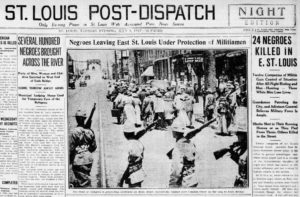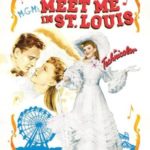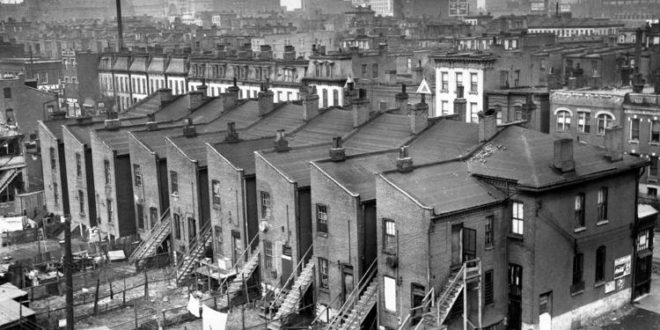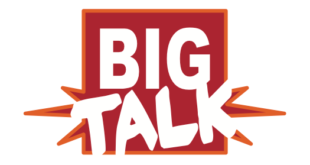Podcast: Play in new window | Download (Duration: 59:00 — 81.0MB)
 Our show today is “Patterns of Segregation and Alibis for Abandonment,” Part 2 of our conversation with Walter Johnson about his book, The Broken Heart of America: St. Louis and the Violent History of the United States published by Basic Books.
Our show today is “Patterns of Segregation and Alibis for Abandonment,” Part 2 of our conversation with Walter Johnson about his book, The Broken Heart of America: St. Louis and the Violent History of the United States published by Basic Books.
The opening song is the main theme from the 1944 musical film “Meet Me in St. Louis” which stars Judy Garland.
The film was adapted from a series of eight short vignettes published first as “5135 Kensington” in The New Yorker and then expanded to twelve for a book compilation with each chapter representing a month of a year from 1903 to 1904 – a year in St. Louis leading up to the opening of the Louisiana Purchase Exposition, also known as the St. Louis World’s Fair.
The author was St. Louis native, Sally Benson who attended the Mary Institute until she moved with her family to New York. The Mary Institute was founded as a school for white girls in 1859. It’s named for the daughter of William Greenleaf Eliot, founder and chancellor of Washington University in St. Louis. It is now located in Ladue, a suburb of St. Louis that has the highest median household income of any city in Missouri with a population over 1,000.
This is one footing upon which the structural racism in St. Louis is founded.

Today’s show takes us from The Dawes Act of 1887 up through the 1954 decision to demolish the Black homes and businesses of Mill Creek Valley and replace them almost literally with nothing.
Along this time line we’ll find novelist and memoirist Theodore Dreiser. From 1892 to 1894 Dreiser was an essential ethnographer of white men seeking “sport” (or vice) with Black women in St. Louis during his time there as a reporter for two newspapers.
The 1904 World’s Fair follows, revealing the scientism of the white imperial project at home and abroad in conquest of the dark skinned barbarians through “education,” put on display in an exhibit called the Human Zoo.
But the barbarism of civilization is forever revealed as we discuss the racial capitalism that fomented the white violence of The East St. Louis Riot of 1917. That violence finds its institutional bureaucratic counterpart in the practices of Harland Bartholomew, perhaps the most influential city planner in U.S. history.
We’ll begin today’s program with a brief discussion of Carl Schurz, a German émigré “revolutionist” who was to become the U.S. Secretary of the Interior in 1877 where he was central in devising ways to rob native populations of their land, and through the Dawes Act turned them into liberal freeholders whose only possessions would be debt.
 GUEST
GUEST
Walter Johnson is the Winthrop Professor of History and Professor of African and African American Studies at Harvard University. His recent books are River of Dark Dreams: Slavery and Empire in the Cotton Kingdom and Soul by Soul: Life Inside in the Antebellum Slave Market.
RELATED
St. Louis: Gateway to Genocide (Part One with Walter Johnson)
The Largest Human Zoo in World History by Walter Johnson
Mill Creek Valley Neighborhood Was Less Important Than An Expressway
The East St. Louis Race Riot Left Dozens Dead, Devastating a Community on the Rise
 MUSIC
MUSIC
“Meet Me in St. Louis” – Main Theme from the 1944 musical film
“Meet Me in St. Louis, Louis” – performed by Billy Murray (1904)
“East St. Louis Toodle-oo” – Duke Ellington and his Kentucky Club Orchestra (1927)
“Thinkin’ One Thing and Doin’ Another” – Miles Davis (1972)
“St. Louis Blues” – Louis Armstrong (1954)
IDs – versions of “St. Louis Blues”
Duke Ellington & Johnny Hodges – Back to Back (1959)
Mary Lou Williams – Nice Jazz: Live at Nice “Grande Parade Jazz” (1978)
Dizzy Gillespie – Have Trumpet, Will Excite! (1959)
Gil Evans – New Bottle, Old Wine (1958)
Dreiser Excerpt
Dave Brubek – “St. Louis Blues” – Jazz Goes to Junior College (1958)
CREDITS
Producer & Host: Doug Storm
Executive Producer: Kade Young
 WFHB Bloomington Community Radio
WFHB Bloomington Community Radio


